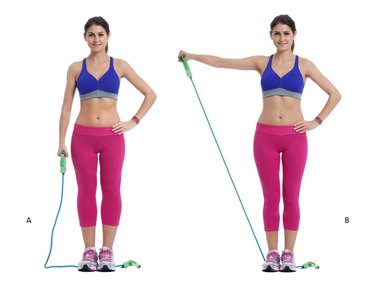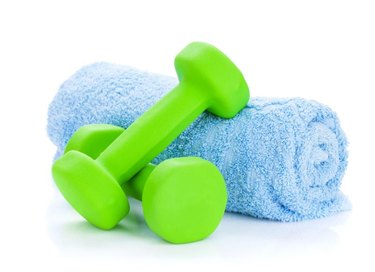
Shoulder bursitis, an inflammation of fluid-filled sacs, can cause debilitating pain. Not only can it keep you from doing the things you love, it can make daily activities such as getting dressed and washing your hair difficult. According to a study published in Journal of Ultrasound, approximately 50 percent of the population in the United States experience shoulder pain at least once per year. Some causes of shoulder bursitis include repetitive shoulder movements — particularly overhead movements — poor posture and weakness of shoulder muscles. Exercises can be performed to improve shoulder bursitis.
Poor Posture
Video of the Day
Whether you're bent over a computer all day or lifting heavy things overhead, poor posture can increase stress on the bursa in your shoulder, leading to bursitis. Poor posture can be improved with shoulder squeeze exercises. Shoulder squeezes strengthen the muscles between your shoulder blades that help you sit up straight.
Video of the Day
Step 1
Sit up straight with your arms against your sides and elbows bent to 90 degrees.
Step 2
Squeeze your shoulder blades together and hold for 3 seconds. Relax.
Step 3
Repeat 10 times, working up to 3 sets in a row.
Read more: Exercises to Correct Bad Posture

Weak Shoulder Muscles
A group of muscles called the rotator cuff are responsible for moving your arm overhead and keeping the ball of your shoulder joint positioned correctly in the socket. When the rotator cuff muscles are weak, bursitis can develop. These muscles perform three main movements of the shoulder: abduction, internal and external rotation. Elastic band strengthening exercises can improve rotator cuff function.

Abduction
Abduction involves moving your arm straight out to the side.
Step 1
Hold one end of the elastic band in your hand. Stand with your feet together and place the opposite end of the elastic band securely under your feet.
Step 2
Keeping your elbow straight, slowly lift the band until your arm is straight out to the side. Hold for 3 seconds, then slowly lower back down.
Step 3
Repeat 10 times, working up to three sets in a row. Remember to stand up straight as you perform this exercise to keep your shoulder in the proper position.
Internal Rotation
Internal rotation involves turning your shoulder in toward your body.
Step 1
Secure one end of the resistance band around a knob or waist-height in a doorframe. Stand sideways with the arm you are going to exercise facing the door, holding the opposite end of the band.
Step 2
Bend your elbow to 90 degrees. Keeping your upper arm next to your body, pull the band in front of you until your forearm reaches your belly. Hold for 3 seconds, then return to the starting position.
Step 3
Repeat 10 times, working up to 3 sets in a row.

External Rotation
External rotation involves rotating your shoulder away from your body.
Step 1
Secure the resistance band in the doorframe at waist-height or around a doorknob as you did for internal rotation. This time, stand sideways with the opposite arm facing the door.
Step 2
Bend your elbow to 90 degrees. Keeping your upper arm by your side, rotate your forearm out and away from your body as far as you can. Do not twist your body. Hold this position for 3 seconds, then slowly return to the starting position.
Step 3
Repeat 10 times, working up to 3 sets in a row.
- Journal of Ultrasound: Prevalence of Subacromial-Subeltoid Bursitis in Shoulder Pain: An Ultrasonographic Study
- American Physical Therapy Association: Physical Therapist's Guide to Shoulder Bursitis
- Best Practice & Research Clinical Rheumatology: Shoulder Disorders and Occupation
- Medicine: Treatments for Shoulder Impingement Syndrome
- American University: Ergonomics Postural Strengthening Exercises
- Santa Monica Orthopaedic and Sports Medicine Group: Scapular Dyskinesis
- Centers for Orthopaedics: Rotator Cuff Home Program
- Kaiser Permanente: Rotator Cuff: Exercises
Is this an emergency? If you are experiencing serious medical symptoms, please see the National Library of Medicine’s list of signs you need emergency medical attention or call 911.